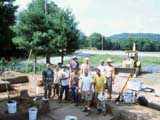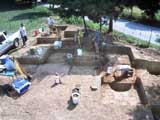The summer of 2000 saw a large crew of Weaver & Associates personnel working at three prehistoric sites near Hohenwald, Lewis County, Tennessee. The Tennessee Department of Transportation plans to widen SR-99, and the three sites are within the area of adverse effect. The largest of these sites, 40Ls20, is a seasonal base camp located near the confluence of Big and Little Swan Creeks. Work at this site included excavation of twenty 2 x 2 units within a shallow midden, after which the site was scraped with a backhoe. In all, 170 subsurface features were identified and excavated, and over 440,000 artifacts, weighing over 1,285 kilograms, were recovered from the excavations. Components range from Paleoindian through the Middle Woodland period.
By about 2000 BC, West Tennessee and the southwestern portion of Central Tennessee came under the influence of cultural traditions originating in the Gulf Coastal Plain. Termed the Gulf Formational period, these influences extended down the Tennessee River Valley to central Perry County, and up the Buffalo River to its headwaters. At 40Ls20, Gulf Formational period fiber tempered ceramics are represented by 96 sherds. These were divided into two varieties: those with a slightly micaceous, contorted paste with dense fiber, and those with a slightly more sandy paste and less fiber. Most of the sherds are plain. The exceptions include two punctated sherds and one simple stamped sherd. One of the punctated sherds was recovered from Feature 154, which was radiocarbon dated to 920±70 BC. The simple stamped sherd was recovered from Feature 139, which was radiocarbon dated at 950±80 BC. This sherd is from a large vessel with a constricting orifice, perhaps a conical jar or caranated vessel with a rim diameter of about 29 cm. This is unusual, as most Wheeler vessels are flat based beakers or simple bowls. The interior of the sherd has grooves resembling scars found on steatite vessels. Two other features with fiber tempered ceramics were dated: Feature 160 returned a date of 860±100 BC, and Feature 162 a date of 830±70 BC. These four dates suggest occupation during the early Bluff Creek phase, tentatively dated between 1000 and 500 BC, and is supported by the absence of later dentate stamped fiber tempered sherds.
In the Pickwick Basin, fiber tempered ceramics are generally accompanied by Wade, Cotaco Creek and Motley projectile points, and possibly Little Bear Creek and Flint Creek. At 40Ls20, these types are present, but are not the most common point types found with fiber tempered ceramics. Of the 24 pp/ks found in feature context with fiber tempered sherds, one is a Motley, one is a Flint Creek, and one a Cotacco Creek. On the other hand, there are five contracting stem cluster points and six occurrences with points of the rounded base cluster. These latter two clusters include some unusual varieties.
The Rounded Stem cluster includes varieties common at Normandy Reservoir and elsewhere on the Highland Rim, as well as points with extremely long stems—some with stems longer than the blades. The closest named type we have found to these points is Cypress Stemmed, a terminal Archaic form found in the lower Ohio River area. The contracting stemmed cluster projectile points also had surprises. Nine could be classified as Gary contracting stemmed. There are 14 distinctive points in this category which might best be associated with Dickson Contracting Stemmed, another Midwest type dating between 500 and 100 BC. An unusual double shouldered point, recovered from Feature 162 with two Dickson Contracting Stem pp/ks, a Cotaco Creek, and a Motley, was dated at 830 BC.
The investigations at 40LS20 suggest the site may have been located at a crossroads between cultures in the Gulf Coastal Plain to the south and west, and aceramic groups to the north and east. As a result of its repeated use as an upland encampment by a variety of groups over time, the value of the site for examining any one group may be minimal, but its value in investigating the sequence of occupations over the long term is, we believe, significant.
Return to Project Index.











